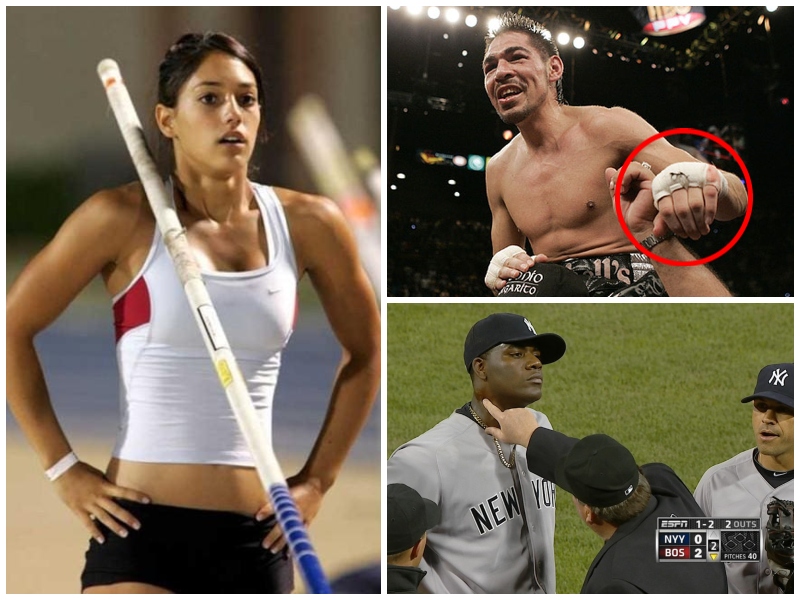
It’s not uncommon for one honorable way to succeed to be matched by a dozen ways to cheat to get there too. These people seem to be the most notorious for doing it dirty over the past few centuries (although let’s stick with the most recent years). One of the main motives is greed for money, but greed for glory could easily be second place.
Here is a ranking of the 50+ infamous sports cheating scandals.
This article was originally published on worldtravelling.com and has been republished here with permission.
57. Josh McDaniels Illegally Filmed Opponents
The Denver Broncos and coach Josh McDaniels were fined $50,000 by the NFL after the team’s video operations director illegally filmed a San Francisco 49ers practice in London in 2010.
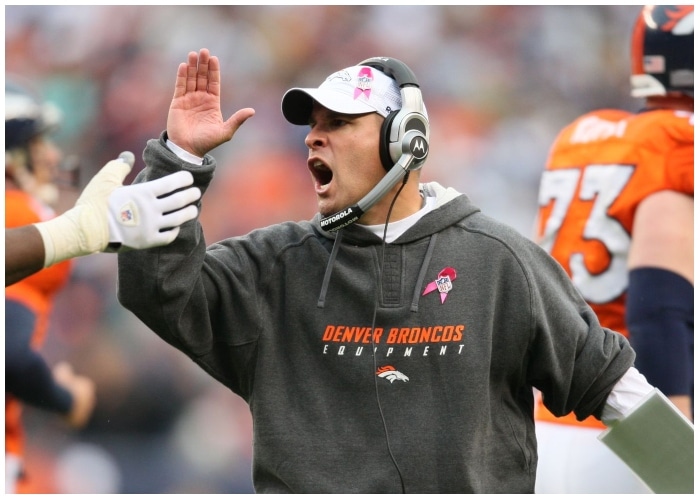
Interviews with Broncos workers and an examination of laptop computers used by the team’s video department were part of NFL security’s investigation. It stained McDaniel’s promising career. The Broncos and McDaniels were each fined $50,000 by the NFL, and Scarnecchia was fired due to the event. Scarnecchia told NFL investigators that he acted alone and “knew it was improper” to videotape the Broncos’ walkthrough session after the rest of the team had left. On the other hand, the NFL penalized McDaniels for failing to report the incident to the league office as soon as possible, as required by the protocol. The NFL also punished the Broncos, which stated that “clubs are ultimately responsible for the conduct of their workers.
56. Australia cricket captain resigns after the inappropriate messaging scandal
Following one of the largest and most embarrassing international crises for the nation, Tim Paine was named the new captain of the Australian test cricket team. But after being investigated by Cricket Australia for sending explicit text messages to a female coworker four years prior, Paine resigned as test captain.
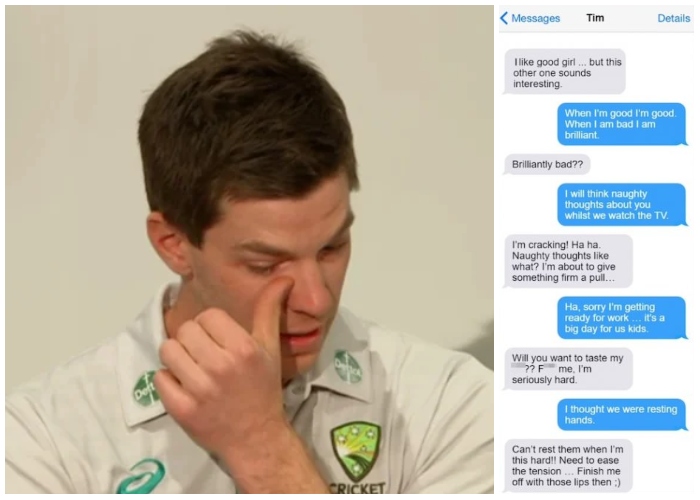
A News Corp. story identified veteran wicketkeeper Paine as the subject of the explicit controversy. The 36-year-old Paine addressed the media in Adelaide to declare his resignation as captain but wanted to stay on the test team. The five-test Ashes series against England began in Brisbane 8 less than three weeks after the announcement.
55. David Robertson, 1985 British Open
Golfer David Robertson was caught putting his ball on the green closer to the cup during the British Open in 1985. Robertson fetched his ball and moved the marker closer to the cup by placing it on his putter instead of the spot.
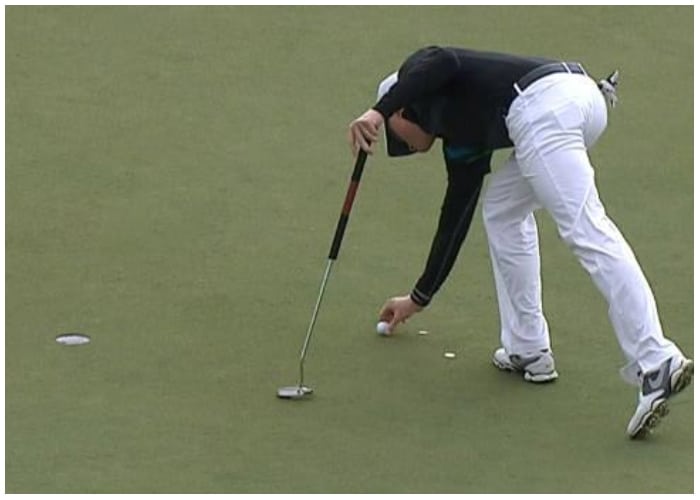
Robertson was fined $30,000 in US dollars and barred from the Pro Tour for the next 30 years. He is only the third player to have been handed such punishment by the European Tour in the past 30 years. David Robertson, the son of a Dunbar butcher, was suspended for 20 years and hit with a 20,000 fine after he was caught cheating in qualifying for the 1985 Open Championship in Kent, and seven years later, Sweden’s Johan Tumba was banned for a decade after he altered his scorecard in a tournament.
54. Thierry Henry’s Hand-Ball
In a 2009 World Cup qualifying soccer match, France defeated Ireland 2-1 thanks to Thierry Henry’s obvious handball. It was perfectly caught on video, as we can see from this picture.

But not long after, a guilt ridden Henry admitted that he handled the ball to help teammate William Gallas retrieve the ball. Ireland erupted in wrath as a result of the missed call. The event is also known as the “second hand of God. After getting a lot of death threats from Irish fans, Thierry Henry said that he was compelled to hire a bodyguard for his daughter. Henry is still reviled by Irish supporters, but fortunately for him, the animosity has subsided since the controversy erupted. On the Robbie Fowler Podcast, Henry claimed, “I was the devil.” “It’s all right. It was something I agreed to. Is it something I’m proud of? No! Do I get abused by Irish supporters every now and then? “I do.” Because I was afraid, my daughter had to go to school with a bodyguard for two weeks”.
53. Ty Cobb Is A Jerk
Ty Cobb was infamous for tripping base runners, cleating infielders, and stealing signs. Cobb’s mother had murdered his father just before his rookie season. He had to endure hazing during his rookie year while going through an emotionally unstable situation.
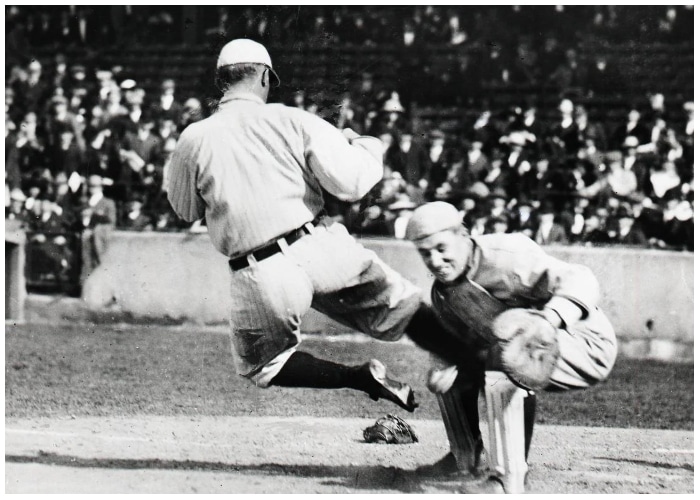
It’s really sad what happened to him, but that doesn’t excuse his dirty play and tripping, which were the worst offenses in baseball at the turn of the century. He misplaced his anger in cheating. A movie about his life was made. The 1994 American biographical film starred Tommy Lee Jones as the baseball player. In his 2015 book Ty Cobb: A Terrible Beauty, author Charles Leerhsen claims that the film is based on Al Stump’s 1961 and 1994 biographies of Ty Cobb, both of which have been criticized for glaring inaccuracies about Cobb’s life, as well as a True magazine article written by Stump after Cobb’s death.
52. Joe Niekro and The Emery Board
When the pitcher digs his sharp fingernails into the ball, it is called a “knuckleball” dance. So it’s understandable that in 1987, while pitching for the Minnesota Twins, Joe Niekro used an emery board and sandpaper in his pocket to keep his nails sharp.
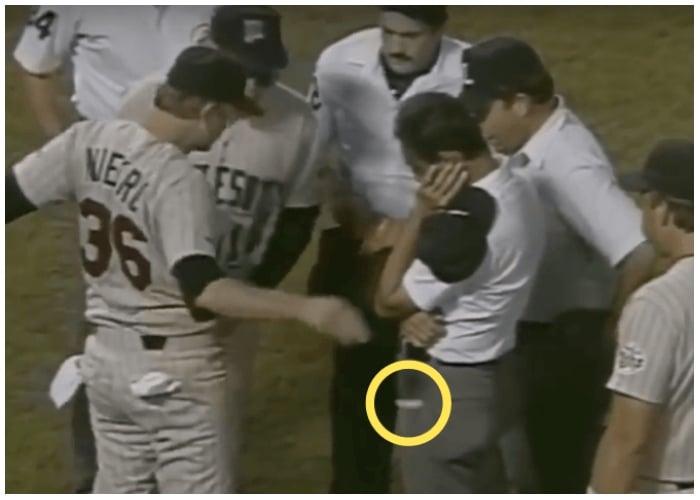
It’s far more plausible, however, that he was tampering with the ball to his advantage. Niekro’s brother Phil sent him a ten-game suspension and a power sander in the mail. Umpire Tim Tschida came out to investigate Niekro. Niekro revealed a nail file in his pocket. When Tschida told Niekro to empty his pockets, Niekro reached into his pockets, pulled out his hands and threw them in the air. An emery board and a piece of sandpaper flew out of his pocket. In 2021, Tschida shared that “[Joe] had a hunk of sandpaper trimmed and glued to the palm of his left hand. It was touched up to look like flesh. And when he wanted the extra movement, he would take off the glove and rub the baseball as if he was trying to improve the grip.”
51. Kenny Rogers Gets Caught
Kenny Rogers started Game 2 of the 2006 World Series for the Detroit Tigers. Cameras caught a strange substance on Rogers’ pitching hand, which was later defined as “soil mixed with rosin.”
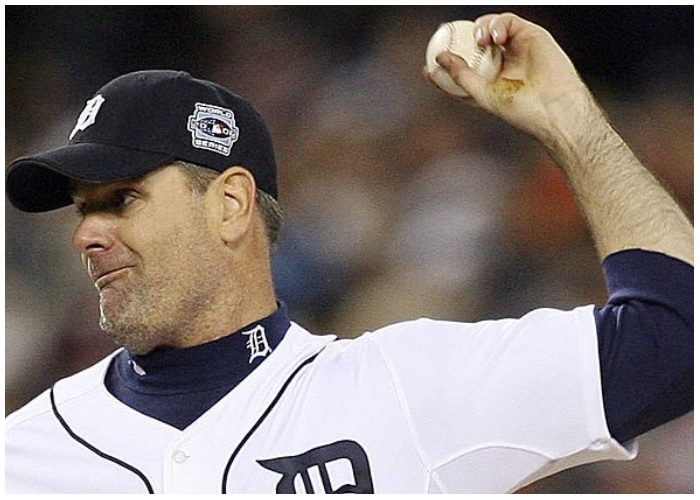
The St. Louis Cardinals accused him of cheating, claiming that the team collected five or six balls with deep scuff marks. He was clearly cheating, but the Cardinals went on to win the World Series, and all of his transgressions faded into the background. The incident was investigated, according to MLB spokeswoman Rich Levin, and the substance was identified as dirt. Rogers was able to stay in the game since it was not considered a foreign substance, as per Rule 8.02. Rogers extended his scoreless streak to 23 innings in the process. Similar smudges were discovered in two other games when photos from earlier games were examined. Rogers retired at the end of 2008 after injuries cut short his 2007–08 seasons. He became the 7th 200-game winner who never won 20 games in a single season, with 219 victories.
50. Brett Hull’s Goal
Brett Hull’s goal gave the Dallas Stars a 1-0 victory over the Buffalo Sabres in the 1999 Stanley Cup Final. Hull’s skate was in the goalkeeper’s crease, which meant that if he took a shot with the puck outside the crease, he wouldn’t be able to score.
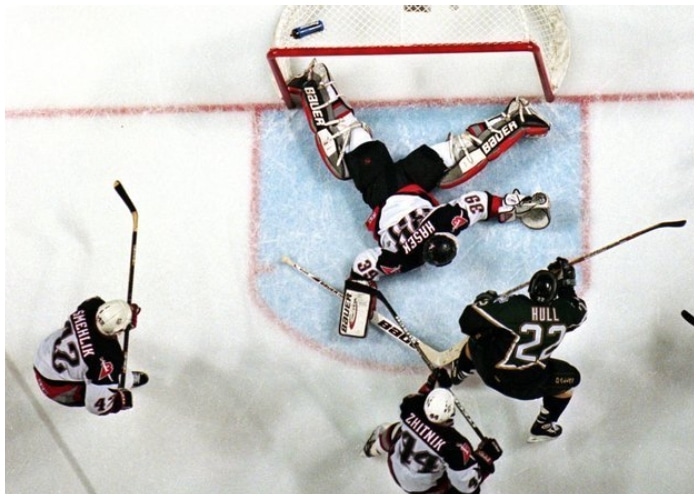
The goal was allowed by the officials because Hull had possession of the puck prior to the shot and so had the green light to attempt the shot. NHL regulations at the time stipulated that a player could not score a goal if any portion of his body was within the goal crease, which the Sabres quickly disputed. Hull’s skate was within the crease when he scored, but the NHL determined that he had possession of the puck before entering the crease, making the goal lawful. A document provided to the league’s on-ice officials before the start of the playoffs addressed that very possibility, according to league officials. Hull himself claims that the goal was legal, bolstering claims that the NHL changed the rules in a private document issued to all teams but not made public.
49. Stanisława Walasiewicz Is Polish For Stella Walsh
Stella Walsh won numerous gold medals for Poland at the 1932 Summer Olympics after winning multiple sprinting prizes in the United States. After being fatally shot in a robbery, her autopsy indicated that she had both XX and XY chromosomes, as well as ambiguous male genitalia.
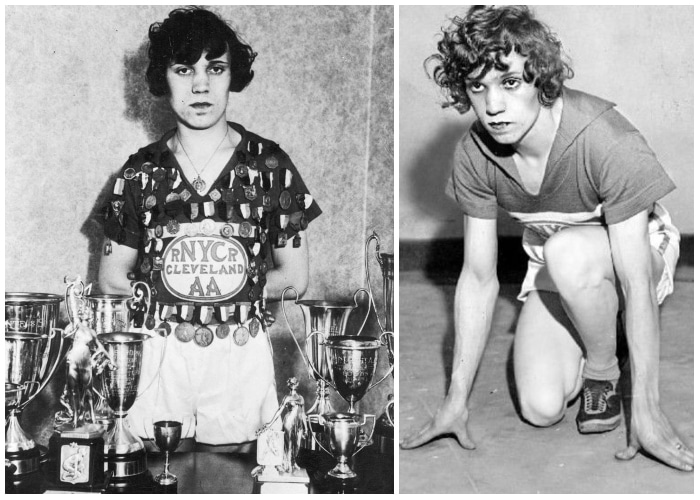
There’s still controversy due to many wanting to erase her records and achievements since they believe she kept her biological advantage a secret. We’ll never know her real story. She remained active in a number of Polish sport organizations in the United States after retiring, where she organized events and assisted new athletes. She also contributed to a number of awards for Polish athletes living in the United States. Stella Walsh was honored by the National Polish-American Sports Hall of Fame in 1974. She was a competitor on the Groucho Marx-hosted radio quiz show You Bet Your Life on June 16, 1954.
48. 1994 Arizona State Basketball Team
Steven Smith and several ASU players were in a controversy involving a local bookkeeper who bribed them to shave points in order to keep them from beating the spread.

After pleading guilty to rigging four Arizona State basketball games and collecting money from gamblers at the close of the 1994 season, Benjamin Silman was sentenced to four years in prison. Silman has done seminars with NCAA athletes to educate them about the hazards of gambling since his release in 2002, and he has written pieces for magazines such as Maxim magazine. Members of organized crime, according to Silman, forced him to continue his scam longer than expected. Big Shot: Confessions of a Campus Bookie, starring David Krumholtz, was adapted into a film based on his story.
47. Chinese Gymnasts Change Athlete’s Age
China utilized an underage girl in the Sydney Olympics in 2000, forging her birth certificate and birth date. In consequence, Dong Fangxiao and her teammates lost their bronze medals, which were awarded to the United States team instead.

The 2008 Olympics are still being investigated for the same reason on behalf of China’s female athletes to achieve fairness in competition. A sports ministry probe using X-ray bone analysis found a fifth athlete of the 15,000 young athletes in the southern Chinese province of Guangdong had misrepresented their age, state media reported. Chinese athletics officials are adamant there will be no repeat of the under-age scandal which ultimately saw a Chinese gymnast lose a bronze medal she won at the Sydney Olympics at the Olympics and other international competitions.
46. Donald Crowhurst Sails To Infamy
Crowhurst, a British businessman, competed in the 1968 Sunday Times Golden Globe Race, a round-the-world sailboat race for single-handed sailors. Crowhurst utilized radio transmissions to suggest he was well ahead of the competition as the race progressed.

In truth, he had docked in the South Pacific, far from his intended destination. He was quickly caught and expelled from the competition. His ship began to take on water soon after he began the race, and he stated that it would most likely drown in heavy waves. In order to appear to have completed a circumnavigation without actually doing so, he quietly abandoned the race while reporting fake positions. The logbooks from his ship, discovered after he vanished, imply that the stress he was under and the resulting psychological deterioration may have contributed to his taking his own life. Crowhurst’s life has spawned a slew of books, stage plays, and films, including a documentary, Deep Water (2006), and two feature films, Crowhurst (2017) and The Mercy (both 2017).
45. Evander Holyfield vs. Mike Tyson
Mike Tyson had previously been humbled by Evander Holyfield, who had defeated him for the World Heavyweight Championship. In the rematch, Tyson bit down on Holyfield’s ear, ripping a small chunk from the top of it.

The fight was called off after Holyfield lost a part of his other ear during the fight. The fight went down in boxing history. The bite was severe enough to remove a chunk of Holyfield’s right ear, which was later discovered on the ring floor. Tyson later explained that his actions were in revenge for Holyfield continuously headbutting him with no consequences. In the uncertainty that followed the bout’s conclusion and pronouncement of the winner, the arena devolved into a near-riot, with numerous people hurt. Tyson-Holyfield II was the first heavyweight title battle to be disqualified in over 50 years.
44. Colorado Football and The Fifth Down
The Colorado Buffaloes faced the Missouri Tigers in 1990 and trailed late in the game. The Buffaloes marched down inside the Tigers’ five-yard line on their final drive. The ball should have gone to the Tigers after a fourth-down run attempt failed.

The Buffaloes, on the other hand, lined up fast, snatched the ball, and scored the game-winning touchdown. In retrospect, it was revealed that the down card was never actually flipped in the confusion. Bill McCartney, the head coach of the Colorado Buffaloes and a former Missouri Tiger, did little to quell the uproar. When asked if he had contemplated forfeiting the game, McCartney said he had, but opted against it since “the field was lousy.” He bemoaned Missouri’s infamous Omniturf artificial turf field, which he claimed had resulted in numerous slips and falls throughout the game. McCartney ended up admitting to making mistakes and being upset by the Fifth Down catastrophe in the summer of 1998, four years after stepping down as the Buffs’ head coach.
43. Three cricketers leave South Africa with bans
Cricket captain Steve Smith was jeered at by onlookers as he was brought through the airport terminal. He is one of the three Australian cricketers embroiled in a scandal over ball-tampering and left South Africa. When the former captain declined to respond to queries from journalists, the crowds chanted “cheater” at him.

In an effort to rehabilitate “integrity” and the image of the sport in Australia following a ball-tampering incident, the three Australians were given extended suspensions.
42. Sylvester Carmouche’s Cheat
At one race, instead of galloping around the mile-long track after the pistol went off, Carmouche paused his horse 200 yards from the finish line and waited for the other horses to close down on him.

Everyone assumed he had won when he kicked his horse past the finish line at full speed. He was banned from racing for a decade. The phantom fog jockey of the Delta Downs race track, accused of hiding his horse in a fog bank and then rushing to victory, was charged with felony theft by fraud and suspended for the rest of the track’s season. It is believed that the jockey remained at that point as eight other horses in the race circled the track, then joined the race as the field approached the final turn. In one-mile races at Delta Downs, horses start out of a straightaway, pass the grandstand, circle the track once, and then finish with a second pass of the grandstand. Carmouche’s horse won the race by 24 lengths but later was disqualified because stewards and track officials suspected that the horse had not run the entire race.
41. Pete Rose and The Illegal Betting
“Hit King” Peter Rose is well known for being accused of betting on games in which he was a manager. In baseball, this is legally prohibited since as a manager, you have the power to make decisions that could affect the game’s outcome.
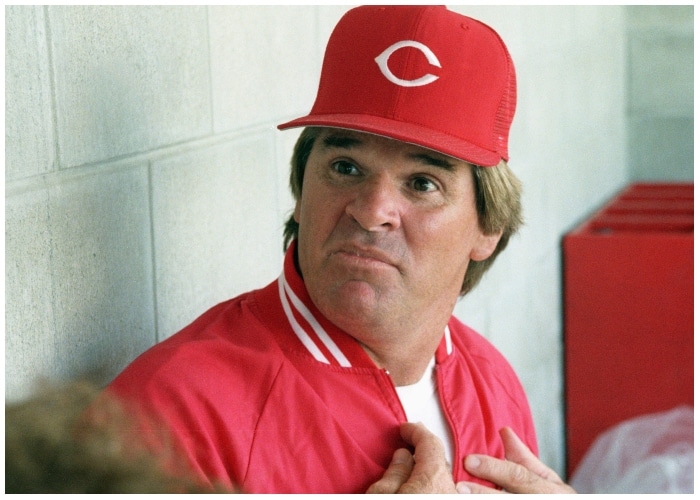
The charges were investigated, and Rose voluntarily accepted a permanent spot on baseball’s ineligible list in 1989. The Baseball Hall of Fame voted two years later to make individuals on the “permanently ineligible” list, which included Rose, ineligible for induction. Before this prohibition, players on the “permanently ineligible” list were technically barred from voting. Rose now joins Roberto Alomar as the only two former players and officials on the ineligible list who are still alive, following the removal of several other figures from the list. Years later, Rose ended up acknowledging betting on baseball games and other sports in 2004. He also admitted to betting on Reds games, but maintained he never gambled against the Reds, in his confession, which was made public in his book, My Prison Without Bars.
40. Park Se Hun Defeats Roy Jones, Jr.
Park Si Hun was overpowered by Roy Jones, Jr. during the 1988 Olympics Gold Medal match in Seoul, South Korea. Hun, on the other side, was victorious in a surprise 3-2 result.
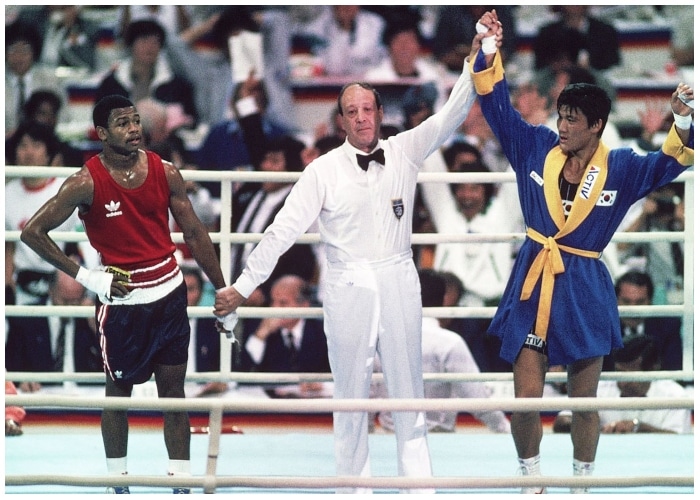
Payoffs and bets that handed Hun the victory were later revealed in German police files. Following the controversy, an investigation into other illogical Olympic achievements was launched. The last South Korean boxer to earn an Olympic gold medal had wished for a silver medal for the previous 32 years. Park’s 3-2 victory over Jones remains one of the most contentious victories in boxing history, as Jones appeared to have dominated the fight from start to finish. Even outraged South Koreans heckled Park at the platform and inundated local TV stations with phone calls screaming that the country’s home advantage had gone too far. Park discreetly retired at the conclusion of the Seoul Games, spending the next 13 years as a middle- and high-school teacher in a rural seaside town before returning to competitive boxing as a coach.
39. Fred Lorz Hops a Ride, Wins a Race
Fred Lorz competed in the 1904 Olympic Games in St. Louis. He ran the marathon in three hours and thirteen minutes, easily beating all of his competitors. He pulled it off by grabbing a lift for about 11 miles with a passing automobile.

Before race organizers found he had cheated, he had already posed for photos with then-first daughter Alice Roosevelt. He was sentenced to a lifetime ban, which was only lifted a year later. Lorz stopped running after nine miles in the marathon due to tiredness (14.5 km). Lorz was given a ride in his car by his management for the following eleven miles (17.7 km), after which he returned to the Olympic stadium on foot, breaking the finishing line tape and being congratulated as the race winner. Lorz was confronted by furious officials after spectators claimed he had not run the entire race, and he admitted his deception: despite his claims that he was joking, the AAU responded by banning him for life, but he was reinstated after a year after it was determined that he had not intended to defraud.
38. Marie Reine Le Gougne Sells Out
Le Gougne said she was pressed by Didier Gailhaguet, the chairman of the French federation, to put the Russians first as part of a pact to give the French ice dance team the gold medal in ice dancing.

The International Skating Union suspended both Le Gougne and Gailhaguet from the sport for three years, although the incidents were never thoroughly investigated. Sally Stapleford, then the chair of the Technical Committee, met her in the lobby and began questioning her about her assessment of the event. She said she was pressed by Didier Gailhaguet, the chairman of the French federation, to put the Russians first as part of a pact to give the French ice dance team the gold medal in ice dancing. However, she later revealed that she had been compelled to suggest the Canadians were better since she honestly believed the Russian duo deserved to win.
37. Rosie Ruiz’s Boston Marathon Shortcut
Rosie Ruiz was the first woman to cross the Boston Marathon finish line back in 1980. She was awarded the laurel wreath and hailed as Boston’s fastest woman.

Rosie had registered for the race but had jumped out of the onlooker crowd and onto the course just a few hundred feet from the finish line, as it was later discovered. Before the Boston scandal, in 1979, she qualified for the New York City Marathon with a time of 2:56:29, good enough for 11th place overall and a spot in the Boston Marathon. Ruiz’s entry for the NYC marathon arrived after the deadline, but the New York Road Runners granted her special permission owing to her allegation that she was dying of brain cancer. Following the 1980 Boston Marathon, officials from the New York City Marathon investigated Ruiz’s performance and determined that she had not completed the entire route, so she was retrospectively disqualified from the race on April 25, 1980.
36. Danny Almonte and The “Age-Gate” Conspiracy
It was discovered that a coach had faked Danny Almonte’s birth certificate, and he had already hit puberty during the 2001 LLWS. The 14-year-old pitcher has a fastball velocity of 70 mph, which is comparable to a 92 mph major league fastball.

When the story came about Almonte mowing down the 12-year-olds he was throwing to,the game’s integrity was questioned. Another team had already engaged a private investigator to figure out Almonte’s true age. A team from Staten Island hired a private investigator to look into the ages of the entire team. There was no evidence that the players were too old. Rolando Paulino, the league president, adamantly insisted that Almonte had in fact been born on April 7, 1989. Reporters from Sports Illustrated went to the civil records building in Moca in the Dominican Republic two weeks after the end of the 2001 Series. They discovered Felipe Almonte had registered his son’s birth date as April 7, 1987 —which would have made him 14 years old at the time of the 2001 Series.
35. Clem Haskins and The College Basketball Fraud
Clem Haskins was a prominent college basketball coach. He was ultimately discovered to have rigged the majority of his athletes’ classes. He persuaded counselors to complete their schoolwork and papers so they could concentrate entirely on basketball.

When he was caught back in 1999, the University was kicked out of the playoffs for several years, and he hasn’t coached since. From 1994 through 1998, Jan Gangelhoff, the manager of the school’s academic counseling office, wrote almost 400 pieces of coursework (including theme papers, homework assignments, and take-home examinations) for 18 Golden Gophers players, including the Gophers’ Final Four run. Haskins was forced to leave after the season because of his role in the infractions. Minnesota’s basketball team was removed from postseason consideration for the 1999–2000 season, the program was penalized 11 scholarships from 2000 to 2004, and various sanctions were levied on the institution.
34. John Calipari Violates Recruiting Rules
After it was rightfully proven that the coach faked guard Derrick Rose’s SATs and had the institution pay for Rose’s brother’s travel expenses, the 2008 Memphis Tigers had their entire season record wiped out.
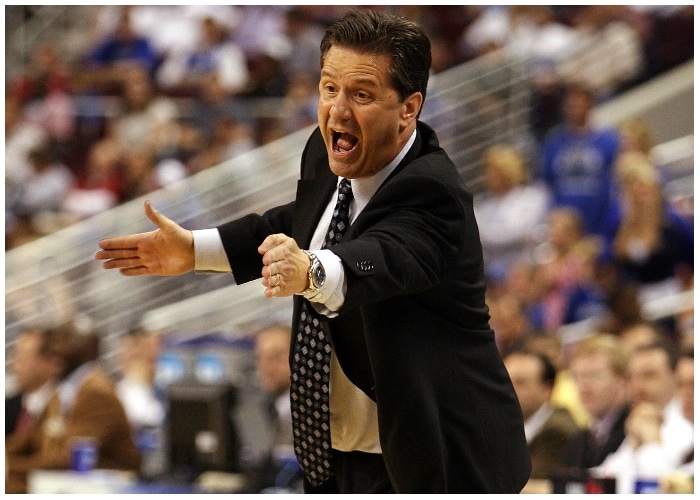
Nowadays, in collegiate sports there is an ugly trend: coaches who know how to break the rules in order to get their teams to the top. Calipari might very well be a fantastic coach, but he has also succumbed to greed. Derrick Rose’s SAT score was invalidated by the Educational Testing Service (ETS), which administers the college admissions test. Rose, despite everything, continues to deny any wrongdoing. The NCAA initiated an investigation into the test, and ETS decided to conduct a review. The ETS sent three letters to Rose’s family’s old Chicago address, requesting that he verify some test information. ETS invalidated his SAT since he did not respond to the letters. Despite the NCAA’s investigation, which concluded that there was insufficient evidence to indicate Rose did not take the test, this occurred.
33. Clint Bowyer’s Illegal Car
After his race car failed an inspection after easily winning in New Hampshire, Bowyer and his team were fined 150 points. His automobile was deemed to be just outside of NASCAR’s tight restrictions for vehicles that compete on the track.

His team would file an appeal, but it would be in vain. NASCAR would not cave into their demands whatsoever. Bowyer is still enraged that Denny Hamlin would win the Sprint Cup Championship Chase. Clint Bowyer’s bid for the Sprint Cup championship was derailed when NASCAR docked him 150 points for failing to satisfy the specifications of the car that won the Chase opener in New Hampshire. Shane Wilson, the crew chief, was fined $150,000 and suspended for six weeks. Richard Childress has been docked 150 points as an owner. With the win, Bowyer moved up to second in the points standings, ending an 88-race losing streak. The penalty dropped him to 12th place, putting him 35 points behind leader Denny Hamlin.
32. John McGraw: Orioles, Cardinals, Giants Utility Man 1891-1906
According to testimonies of former teammates, McGraw would trip players nearing second base, grab the belt loops of base runners tagging up at third base, or step in front of them to slow them down.
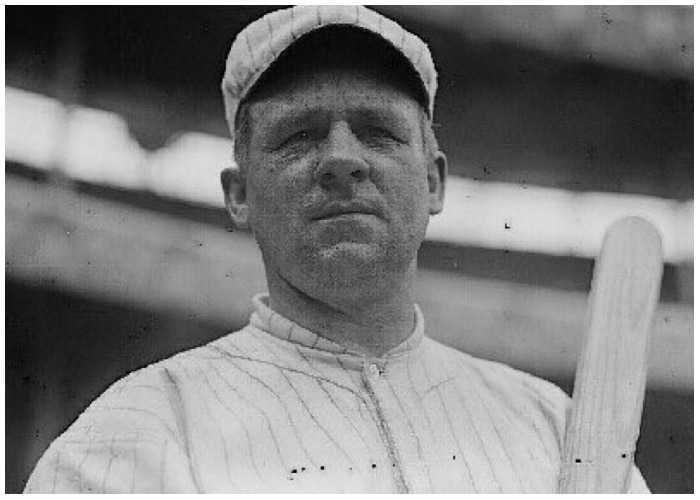
McGraw had an impressive 155 pound physique which could have intimidated anyone who opposed him. He was known to be a bit of a bully. McGraw was born into an abusive family, with his father as the culprit. McGraw became harsh, rude, and dirty to fit in when he started playing professionally at the age of 13. He was the team’s roughest and hardest player at the age of 19. McGraw would play games on the field, and they weren’t always funny—at least not to the opposing side. He would grab a player’s belt at third base to prevent him from scoring. He would occasionally tackle a runner. Put McGraw on your squad if you want an opposing pitcher to throw a lot of pitches. With his remarkable ability to foul pitches off time and over, he earned a reputation for wearing down pitchers.
31. Dora Ratjen and High Jump
During the 1936 Olympics, an athlete named Hermann was persuaded to bind his genitals tightly to his body in order to compete against other women in the women’s high jump competition. He came in fourth place.
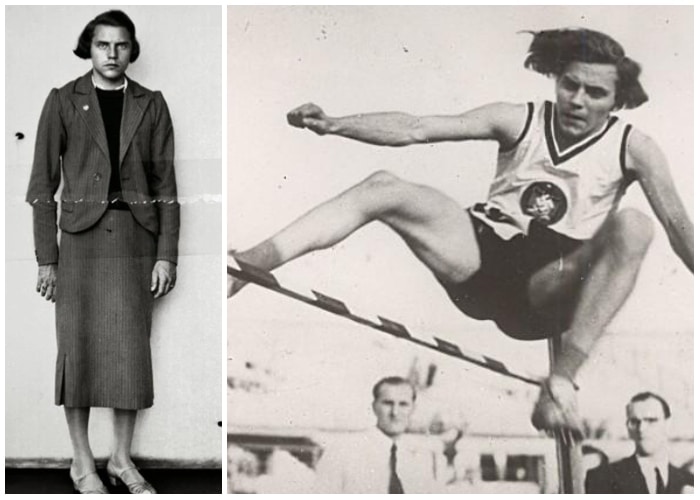
The rumor has been for years that Ratjen later spoke out, stating that the government forced him to do this in order to help win more medals for Germany at the 1936 Berlin Olympics. According to Der Spiegel, Dora, then Heinrich Ratjen, later known as Heinz, was handed a new ID and employment documents by the Reichsarbeitsdienst and sent to Hanover “as a working man.” Before his death in 2008, he took over the running of his parents’ pub and ignored all requests for interviews. Dora had presented herself as Hermann, a waiter in Bremen, “who sadly revealed that he had been forced to masquerade as a woman ‘for the sake of the prestige and glory of Germany,'” according to Time magazine in 1966. ‘I lived the life of a girl for three years,’ Hermann sighed. ‘It was a complete bore.’
30. Antonio Margarito’s Plaster of Paris
Officials seized Antonio Margarito’s wraps in 2009 after a suspicious chemical was discovered on damp pads inside his gloves. Margarito’s gloves had too much wrap, so Shane Mosley’s corner requested a review.

The chemicals were recognized as “Plaster of Paris,” a mixture of elements that hardens when wet and it would have turned his gloves into rocks and blunt-force weapons. Margarito and his trainer, Javier Capetillo, were suspended by the California State Athletic Commission in late January pending an investigation. Margarito claimed he had no idea what was in the wraps throughout the hearing, while Capetillo admitted to making a “huge error” by putting the improper inserts in Margarito’s hand wraps. Margarito and Capetillo’s licenses were unanimously revoked for at least one year by the commission. While it was discovered that Margarito was unaware of the gloves, it was decided that as the team’s leader, he was liable for Capetillo’s actions.
29. Tom Brady and Deflategate
Tom Brady is widely regarded as the greatest quarterback in history. But his participation in the historic ‘Deflategate’ controversy is something that will follow him forever.
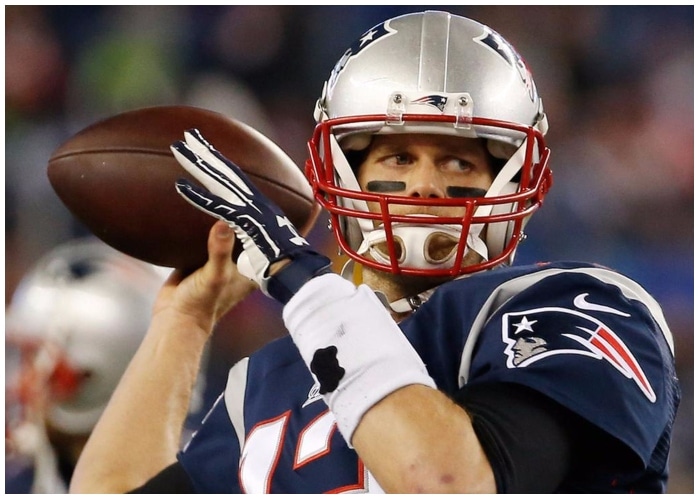
During the 2015 playoffs, Brady and the Patriots allegedly conspired to deflate balls to make them easier to throw and catch. The team was fined $1 million and Brady was suspended for four games. The NFL released a 243-page report into the deflation of footballs used in the previous season’s AFC Championship Game on May 6, 2015. According to the research, Brady was most certainly aware of the deliberate deflation at least in general. The NFL penalized Brady for four games on May 11 for his role in the deflategate scandal, citing “strong and credible evidence” that he knew Patriots staffers were inflating footballs and that he was uncooperative with investigators.
28. Sammy Sosa and Albert Belle Bat-Corking
When Sosa was hit with an inside fastball, his bat cracked into a smattering of pieces, revealing a cork lodged in the barrel’s beginning. He was discovered to be a cheater.
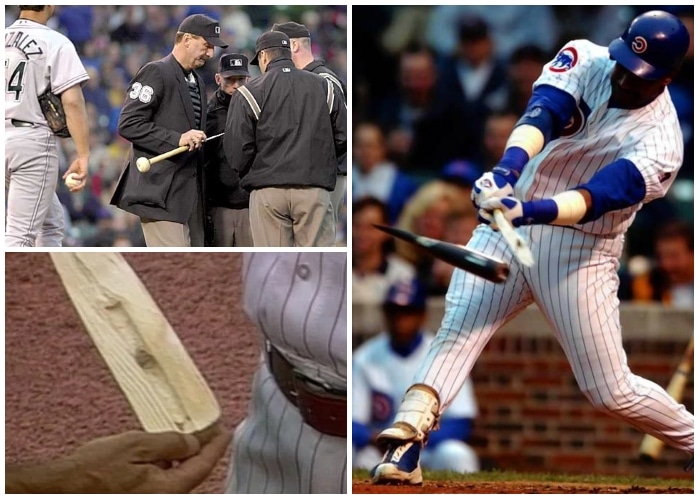
Sosa claimed it was an unintentional mix-up of a practice bat with his game-time rotation. His already tainted reputation was further harmed when he was rightfully suspended for these acts. The New York Times revealed on June 16, 2009, that Sosa was among the players who tested positive for performance-enhancing drugs in 2003. The information was obtained from unnamed attorneys with knowledge of Major League Baseball drug test results from 2003, according to the article. Sosa previously appeared before Congress in 2005 alongside Rafael Palmeiro, Jose Canseco, and Mark McGwire. On his behalf, his counsel testified, saying, “To be clear, I have never used performance-enhancing medications that are unlawful. I’ve never injected myself or allowed anyone else to do so. I have not committed any laws in either the United States or the Dominican Republic. I was tested in 2004 and was found to be clean.”
27. Hansie Cronje, The Bad Boy of Cricket
In 1999, authorities in Dehlia, India, reported that Hansie Cronje, who was the most famous cricket player in the world, was caught on tape discussing the tossing of matches for thousands of dollars.
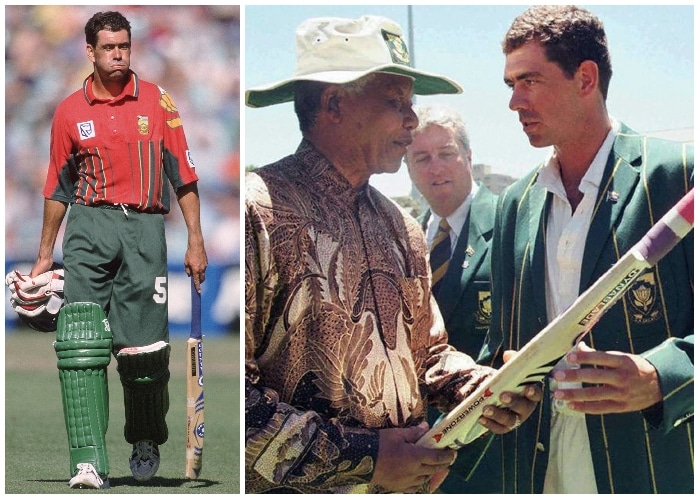
Cronje was given a lifelong ban, but he lost his life in a plane crash in June 2002 while attempting to overturn the decision of the panel. Cronje had more than 70 bank accounts in the Cayman Islands, which were unlawful since they were not notified to the South African Revenue Service, according to subsequent reports on his involvement in match-fixing. The South African probe came to an end when he died, but the many stories implied that match-fixing was far more pervasive than the King Commission had discovered. The chargesheet in the case involving a few South African cricketers, including former captain Hansie Cronje, was ultimately submitted on July 22, 2013, 13 years after the Delhi Police opened a FIR for match-fixing in 2000.
26. Tim Donaghy Shames His Name, and The NBA
From 2005 to 2007, the former NBA official purposefully blew or made wrong calls in order to win wagers on game point spreads. The FBI looked into it, and he was found guilty and sentenced to 15 months in prison.
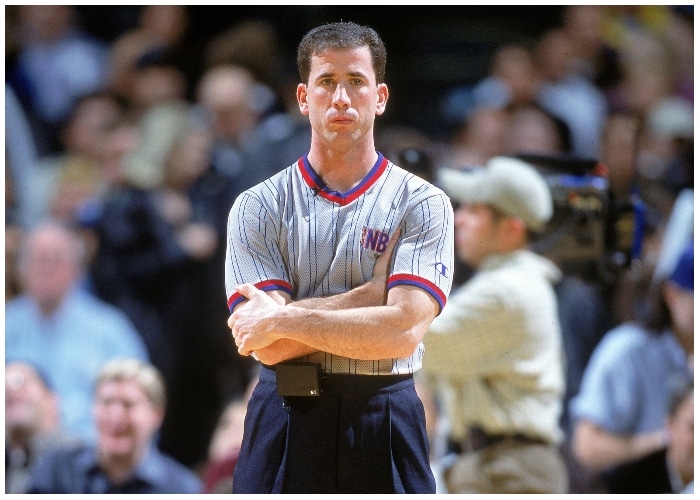
This case shows the greed of not just on players and coaches, but also on officials who are put in high-pressure situations with large sums of money at stake. This time it was the referees. During the 2007 Board of Governors meeting, NBA Commissioner David Stern tightened the standards on NBA referee behavior as a result of the betting incident. Despite the fact that referees are prohibited from practically all kinds of gambling under their collective bargaining agreement, it was revealed that about half of the NBA’s officials have placed bets in casinos, though not with bookmakers. “The ban on gambling is absolute,” Stern said, “and in my opinion, it is too absolute, too harsh, and has not been well-enforced over the years.” The gambling rules were changed to allow referees to gamble on a variety of things other than sports.
25. The CCNY Point Shaving Scandal
Back in 1951, The City College of New York basketball team was found out to be shaving points in a gambling scandal involving several other schools and around 30 of their players. It was one of the first reports of college basketball players shaving points in collegiate sports history.
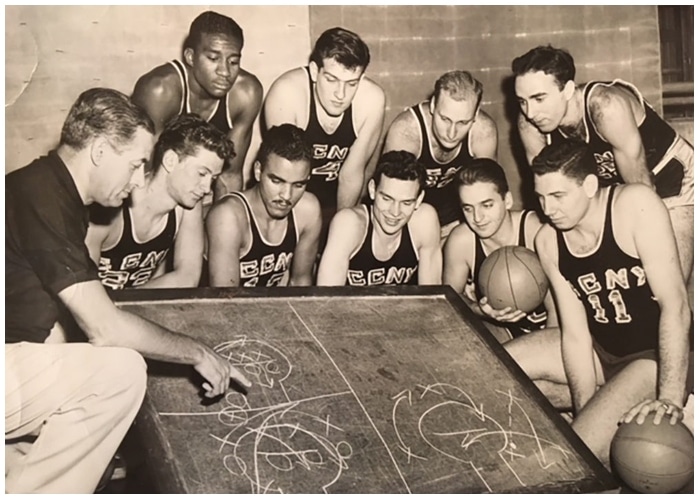
In reference to the things we get to know about in the news about today’s college sports, this seems a mild case of child’s play. Some of the individuals involved, as well as college basketball itself, suffered long-term consequences as a result of the scandal. Long after the incident had passed, coaches would caution their players about the consequences of choosing to make “quick money.” Following the revelation of multiple other infractions, CCNY decided to downgrade its athletic program to Division III. From 1951 to 1957, LIU suspended its entire athletic program and did not return to Division I until the 1980s.
24. Marie-Reine Le Gougne
Figure skating has often been marred by controversies questioning the impartiality and honesty of its judges. Marie-Reine Le Gougne pushed these doubts to the forefront during the 2002 Winter Olympics. Her obvious favoritism led to immediate confrontation by the Technical Committee’s head.

Investigations revealed that she was under the influence of the French team, who were attempting to sabotage Canada’s scoring for their own advantage. Consequently, the International Skating Union suspended Le Gougne and awarded both Russia and Canada dual gold medals.
23. Arnold Schwarzenegger
Despite being a symbol of integrity, Arnold Schwarzenegger’s reputation is slightly marred due to his past. He admitted to steroid usage during his bodybuilding days, arguing that staying competitive was necessary.

However, it’s important to note that Schwarzenegger refrained from performance-enhancing pills in his powerlifting and weightlifting endeavors. Even though steroid use was rampant among his contemporaries, it didn’t absolve him from his ethical responsibilities.
22. East German Women’s Swim Team
It’s not common for an entire nation to be tainted with cheating, but that’s precisely what happened to East Germany, mainly due to their handling of the female swimming team from 1968 to 1980.
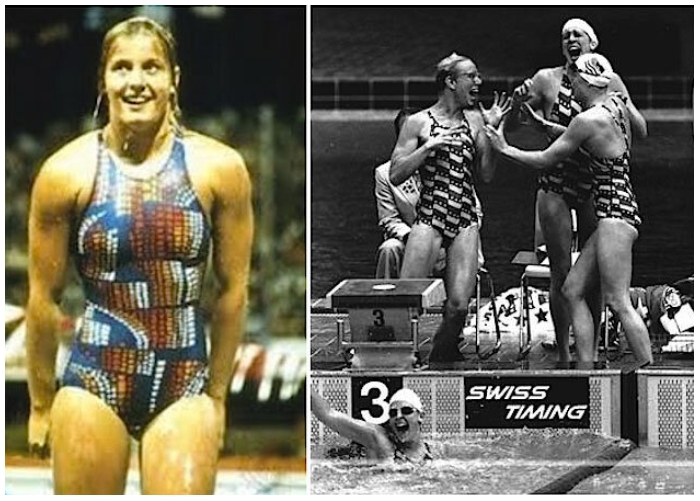
The team’s enhanced strength and size raised eyebrows. It was later discovered that the state and its Olympic committee had been providing the athletes with steroids and hormones disguised as vitamins. This unfair advantage enabled them to dominate the competition for over a decade until their deceit was exposed.
21. Ben Johnson
Suspicion arose immediately after Ben Johnson’s remarkable performance at the 1988 Olympics. His exceptional physique and unrivaled dominance prompted the Olympic committee to strip his gold medal merely three days after he won the 100-yard dash.
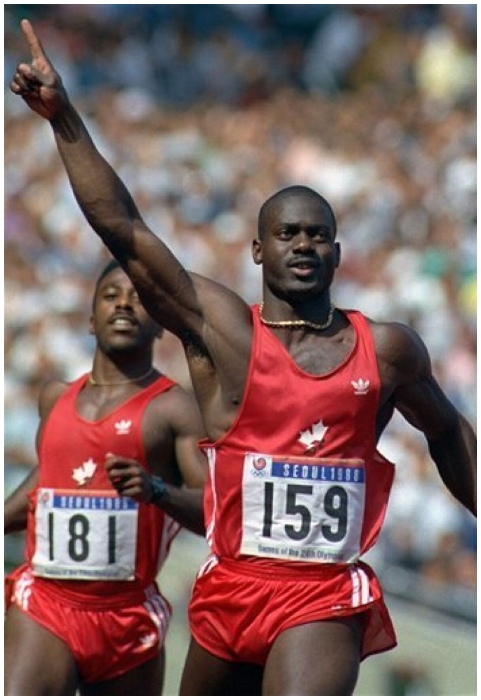
Johnson had set a new world record by completing the race in just 9.79 seconds. However, following a failed chemical test, his record was nullified. He was found to have used Stanozolol, one of the most potent anabolics available.
20. Mark McGwire
The legacy of Mark McGwire, like many other baseball sluggers from the 80s and 90s, is overshadowed by the specter of pills. Though never officially caught, many suspected him of steroid use throughout his career.
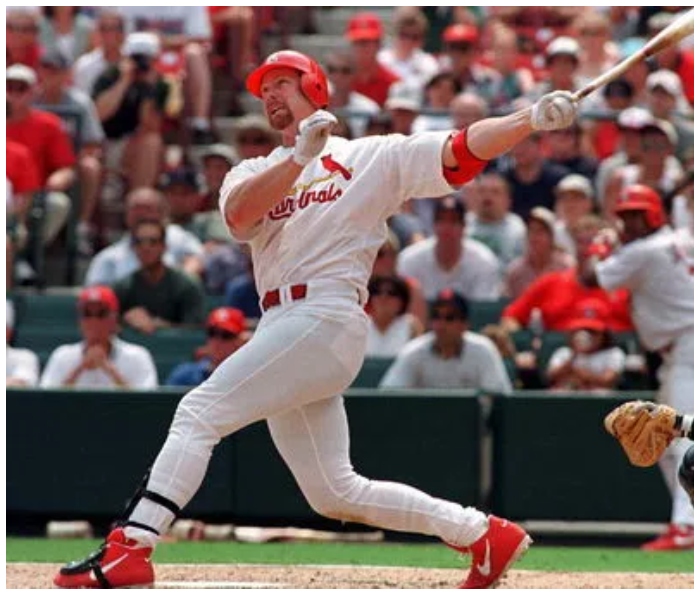
McGwire eventually admitted to pill usage ten years post-retirement, confirming what had already been revealed by the BALCO scandal. He confessed to a pattern of pill usage from early in his career, albeit intermittently.
19. Carl Lewis
Carl Lewis, a prominent rival of Ben Johnson, ironically became the recipient of Johnson’s stripped gold medal due to Johnson’s steroid usage. However, it later emerged that Lewis himself had been using steroids during the competition.
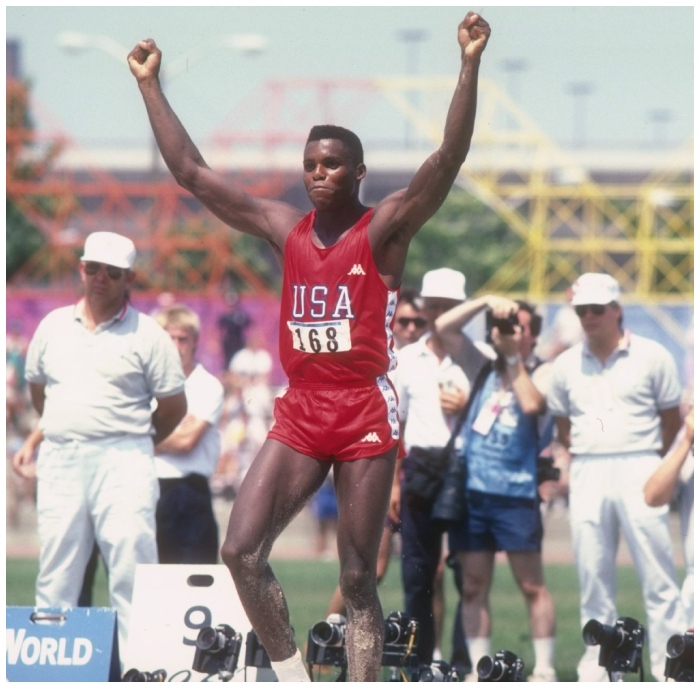
Reportedly, officials had even covered Lewis’s failed pills tests before the Olympics. Lewis later admitted to using his pills, but the damage was irreversible.
18. José Canseco
José Canseco, colloquially known as ‘The Godfather of Steroids,’ is an inevitable inclusion in this list. Once revered as one of baseball’s top power hitters, his legacy is marred by his admitted reliance on banned substances.

Unapologetic about his choices, Canseco even champions steroid use in sports, evidenced by his book, “Juiced: Wild Times, Rampant’ Roids, Smash Hits & How Baseball Got Big.” He also outed several former teammates as fellow steroid users.
17. Houston Astros
The 2017 Houston Astros demonstrated an unnerving invincibility at home, leading them to a World Series victory against the Los Angeles Dodgers.
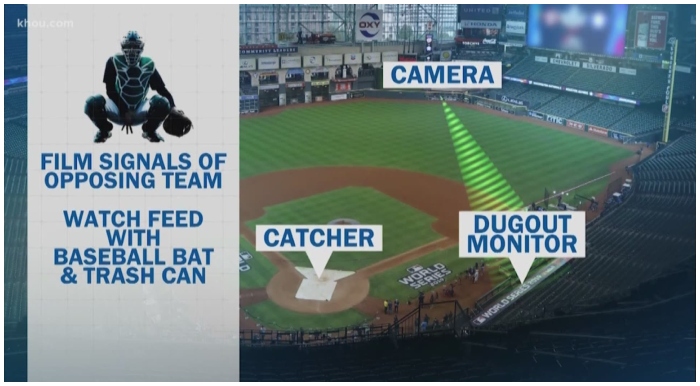
However, their shining triumph was later tarnished. Mike Fiers, a former Astros pitcher, exposed a scheme of sign stealing masterminded by Álex Cora and Carlos Beltrán. The fallout led to hefty fines and the suspension of Cora, AJ Hinch, and Jeff Luhnow. Players involved were granted immunity for their cooperation. Despite the scandal, MLB did not revoke the Astros’ championship title.
16. New York Giants
Before the Houston Astros scandal, the 1951 New York Giants faced the wrath of their peers for a sophisticated sign-stealing scheme. The result was an exceptional offense that was difficult to match.
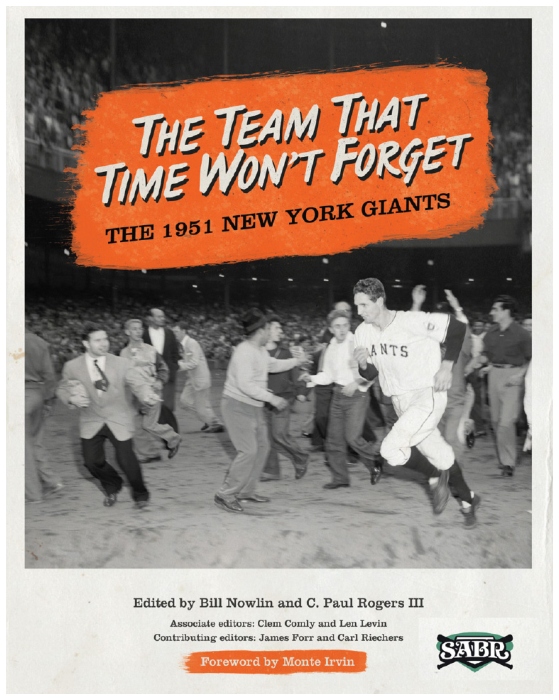
The Giants used an elaborate system of buzzers, telescopes, and even bells to decode the catchers’ signals, giving their hitters a significant advantage. Fortunately, justice prevailed, and despite their underhand tactics, the Giants lost the 1951 World Series to the New York Yankees.
15. Marion Jones
Once celebrated as an American hero, Marion Jones’ golden reputation was tarnished when her illegal pill usage was revealed. A commanding presence on the track, Jones won five Olympic medals, including three golds. Still, whispers of pill use were never far behind.
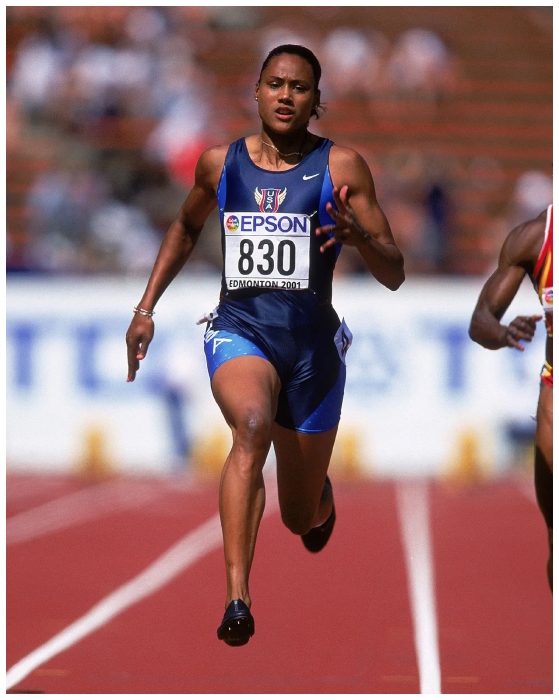
Finally, in 2004, it was confirmed that she had been receiving steroids from BALCO. This infamous lab provided pills to numerous Major League Baseball players. The fallout forced Jones to relinquish all her medals and resulted in the loss of her multiple endorsements.
14. Calciopoli Rigging Scandal
Calciopoli exposed something that had been happening in Italy for decades. It was evident that the officiating was favoring some of the country’s major clubs, and the investigation revealed that Juventus, AC Milan, Fiorentina, Lazio, and Reggina were all rigging games.
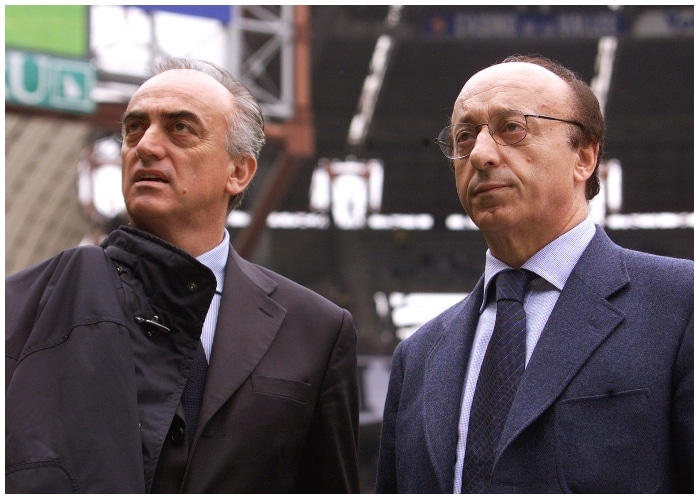
Juventus had many trophies removed from them as a result of the scandal and was relegated to Serie B. The controversy was exposed in May 2006, after a series of phone interceptions revealed ties between club managers and referee groups during the 2004–05 and 2005–06 seasons, with the latter being accused of favoring certain officials. Many sporting directors and referees received prison sentences, but after nearly a decade of investigation, all were acquitted in 2015 due to the statute of limitations expiring, with the exception of referee Massimo De Santis, who received a one-year sentence confirmed.
13. Houston Astros’ Sign-Stealing Scandal
One might argue about individuals using steroids and never getting caught. Still, nothing compares to organized cheating on the scale of the Houston Astros’ 2017 sign-stealing scandal. Utilizing ballpark cameras to decode opponents’ signs, which were then communicated using trash can lid bangs, the Astros executed this scheme during the 2017 and 2018 seasons. This includes the 2017 playoffs and their World Series triumph over the Los Angeles Dodgers.
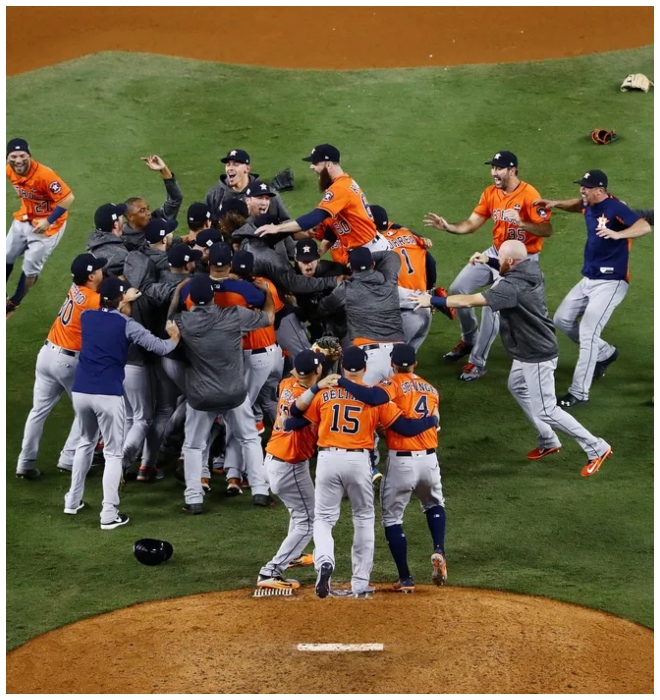
As a result of an immunity deal with MLB, the players who implemented this scheme faced no punishment. However, General Manager Jeff Luhnow and Manager AJ Hinch were fired and suspended for the 2020 season. Boston Red Sox manager Alex Cora, who was Hinch’s bench coach during the scandal, was also suspended for the 2020 season, leading the Red Sox to sever ties with him. Hinch and Cora have since returned to managing in the majors.
12. The Luis Resto Scandal
In a shocking event in 1983, Luis Resto, a journeyman, defeated the undefeated junior middleweight Billy Collins Jr. at Madison Square Garden. Resto, known for his soft punches, battered Collins to the point of swelling his eyes shut, causing an iris tear that blurred Collins’ vision and ended his boxing career.
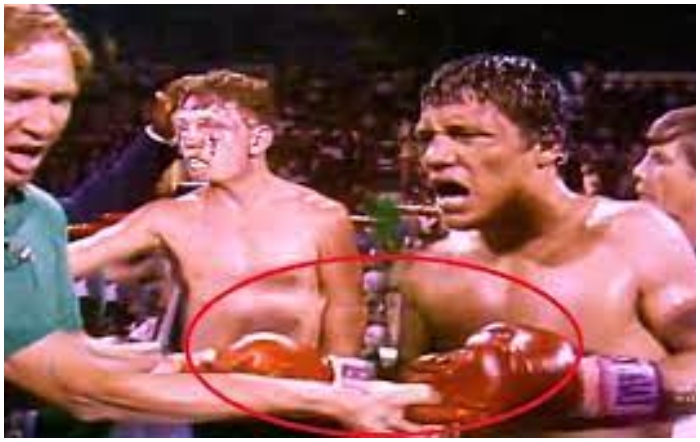
When Collins’ father, also his trainer, shook Resto’s hand at the match’s conclusion, he felt Resto’s gloves were unusually thin. An ensuing investigation revealed an ounce of padding was removed from each glove and replaced with chalk, a fact Resto admitted to in 2007. Resto served two and a half years in prison for very problematic behavior. Tragically, Collins died in a car crash in 1984, with his family attributing his deteriorated mental state to the loss of his boxing career.
11. Pills in MMA
Numerous MMA fighters have been caught doing forbidden stuff, making it challenging to single out one individual. In 2000, Josh Barnett became the youngest heavyweight champion in UFC history by defeating Randy Couture, only to be stripped of his title after testing positive for a banned substance.
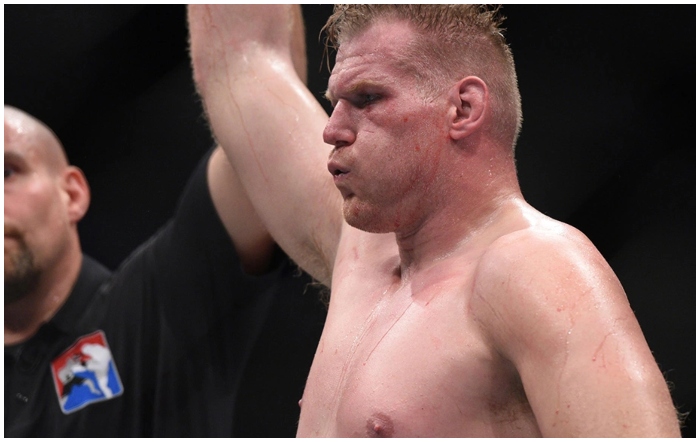
Royce Gracie, an iconic figure in MMA history, tested positive after his 2007 rematch with Kazushi Sakuraba. Other renowned MMA fighters who tested positive include Anderson Silva, Nick Diaz, Cris Cyborg, and Chael Sonnen. Even Jon Jones, an MMA great, tested positive recently. In an individual sport like MMA, pills are the predominant form of cheating; unfortunately, it is far from uncommon.
10. Maradona and The Hand Of God
At the 1986 World Cup quarter final between England and Argentina, Diego Maradona “scored” possibly the most contentious goal in soccer history. He smacked the ball into the net with his left hand, but to referee Ali Bin Nasser it looked like a header.
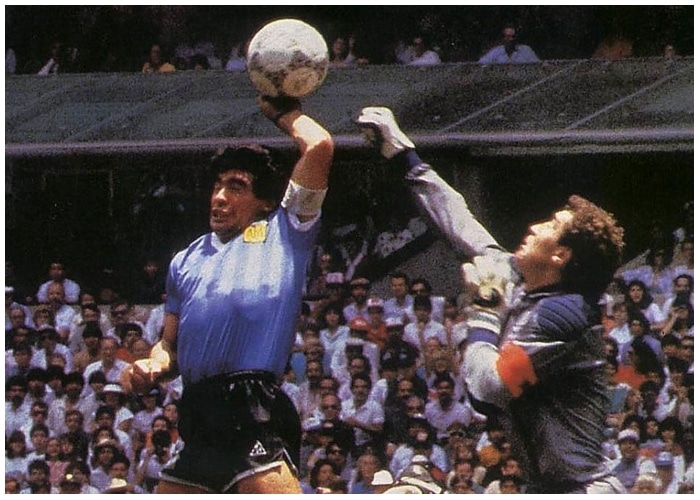
And this is how the famous phrase of the “Hand of God” came to be. In the first half of Argentina’s 0–0 draw with the Soviet Union in the 1990 World Cup, a Soviet attack was foiled when Maradona intercepted the shot with “the hand of God” without the referee noticing. On June 9, 2007, during a league match against Espanyol, Lionel Messi of Argentina scored by flinging himself at the ball and guiding it past the goalie with his hand, similar to Maradona’s Hand of God goal.
9. Barry Bonds
Barry Bonds was undoubtedly one of the most formidable sluggers MLB had ever witnessed. His records for most walks (2,258), most home runs in a season (73), home runs (762), consecutive seasons with 30+ home runs (13), the highest slugging percentage in a season (.861), and MVP titles (7) are still unmatched.

Nevertheless, his illustrious career was controversial when he was implicated in the BALCO scandal. He had been using nearly undetectable steroids for most of his career. He was indicted for perjury and obstruction of justice for lying under oath. Bonds is now widely considered the most notorious cheater in MLB history, a significant allegation given the sport’s history.
8. Alex Betrays His Teammates
Famous American baseball player Alex Rodriguez was accused of tipping pitches to opponents in lopsided games in the state of Texas in 2009. What makes this so worrisome is that Major League Baseball teams play each other multiple times over the season, frequently three times in a series.

It is also untrustworthy and betraying teammates. Rodriguez is used to being the focus of media smears, but this one appears to be out of his league. Rodriguez tested positive for testosterone in 2003, according to Sports Illustrated on February 7, 2009. Rodriguez’s name was on a government-sealed list of 104 major-league players who tested positive for performance-enhancing substances (out of 1200 tested). The study was created as part of a 2003 survey conducted by Major League Baseball to determine if mandated random drug testing protocols were warranted. There was no penalty or consequence for a positive test at the time. Rodriguez first declined to comment on the charges, deferring to the players’ union. Then he acknowledged using illegal performance-enhancement substances from 2001 to 2003 two days after the claims were made, alleging that he had stopped using them after spring training that year.
7. 1919 Chicago White Sox Mob Scandal
This was dubbed the largest sporting scandal of all time. Eight players of the 1919 Chicago White Sox allegedly lost the World Series intentionally to the Cincinnati Reds as part of a gambling operation directed by infamous criminal Arnold Rothstein.
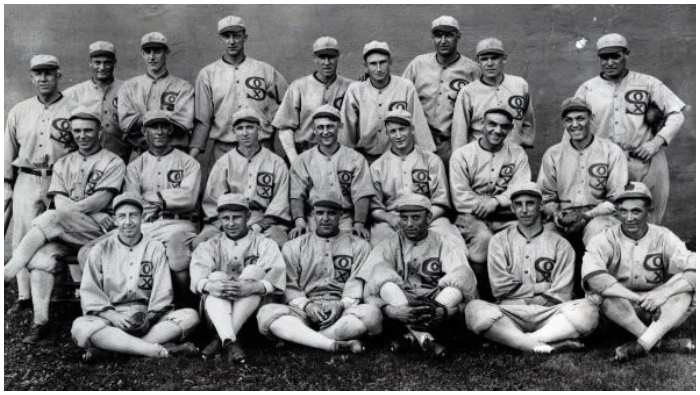
They accepted bribes from the mob and were banned from the game forever, as well as Hall of Fame recognitions. When White Sox President Charles Comiskey was brought to the stand at the trial, he became so irritated by the defense’s inquiries that he sprang up from his witness chair and shook his fist at the defendants’ attorney, Ben Short. The most explosive testimony came the next day, July 19, when “Sleepy Bill” Burns testified that members of the White Sox had purposefully fixed the 1919 World Series; Burns mentioned Rothstein among others, and testified that Cicotte had threatened to throw the ball out of the park if the White Sox needed to lose a game. The jury deliberated for less than three hours before finding all of the accused players not guilty of all charges.
6. Bill Belichick and The Spygate Scandal
The New England Patriots’ head coach Bill Belichick was fined $500,000 and a first-round draft pick in the 2008 NFL Draft after being caught taping New York Jets defensive signals.
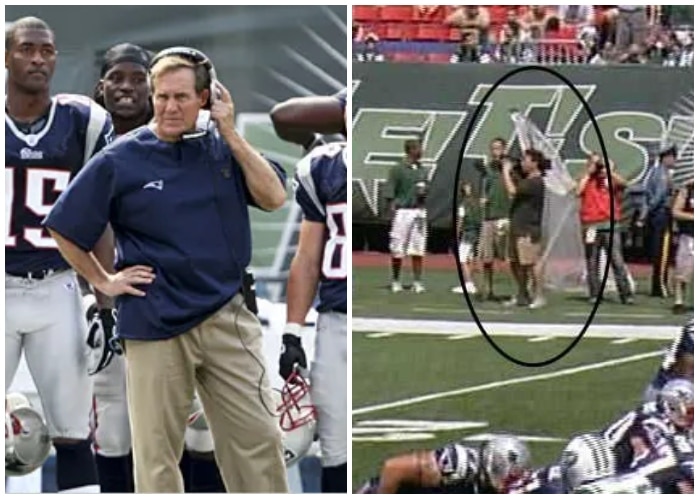
The most ironic aspect of the situation was that Belichick was awarded Coach of the Year back in 2007. Some people are willing to do illegal stuff to win. On September 13, the NFL penalized Belichick $500,000 and the Patriots $250,000, making it the highest sanction ever imposed on a coach in the league’s 87-year history. In addition, the Patriots gave up their first-round draft pick in the NFL Draft in 2008. NFL Commissioner Roger Goodell, a former Jets employee, penalized the Patriots as a group because Belichick has so much control over the team’s on-field operations that “his actions and decisions are properly attributed to the club,” according to Goodell. Goodell considered punishing Belichick but felt that depriving the Patriots of draft picks would be more serious in the long run.
5. Gaylord Perry: Spitball Specialist
Gaylord Perry is a Hall of Fame pitcher who was threatening, domineering, and a big cheater. Perry was well-known for purposely putting Vaseline beneath the bill of his cap, in his waistline, and even under his sleeve in order to throw a so-called “spitball.”
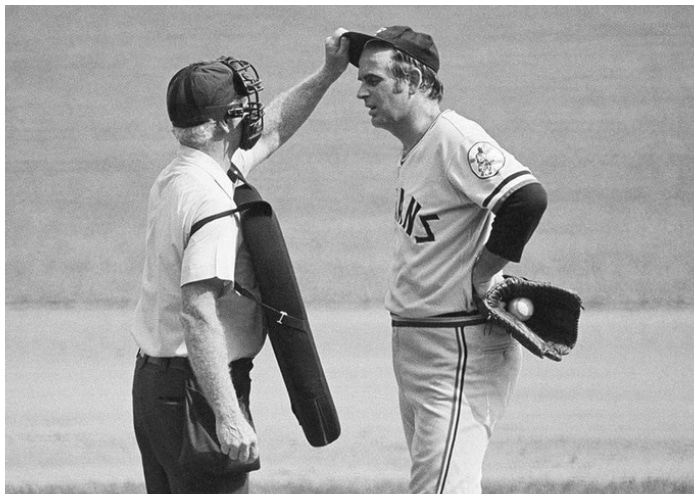
These were forbidden due to the difficulty in controlling the pitch’s trajectory. From 1962 to 1983, Perry was a member of the Giants, Indians, Rangers, Padres, Yankees, Braves, Mariners, and Royals. Pitcher Bob Shaw allegedly taught Perry the spitball in 1964. Perry had a reputation for doctoring baseballs throughout his career, and he was constantly inspected on the mound by umpires and watched intently by opposing teams. He was removed from a game against the Boston Red Sox on August 23, 1982, and given a 10-day ban for doctoring the ball. Perry is said to have approached Vaseline’s makers about endorsing the product, but was turned down with a one-line postcard that read, “We comfort babies’ backsides, not baseball.”.
4. Lance Armstrong and His Illegal Secret to Perform
Until it all turned out to be a farce, he was one of the most famous athletes in American history. Lance Armstrong, who won seven Tour de France titles in the 1990s and 2000s, was the greatest racing cyclist of all time.
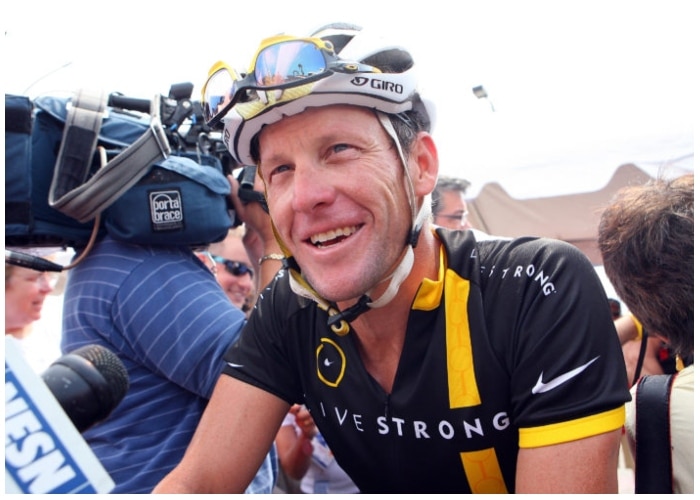
However, in 2012, an investigation revealed that he had used performance-enhancing pharmaceuticals for the majority of his career. All his achievements were all wiped from the record books. Armstrong was chastised for collaborating with shady trainer Michele Ferrari. Ferrari stated that Eddy Merckx introduced him to Lance in 1995. Tour de France organizer Jean-Marie Leblanc said, “I am not happy the two names are mingled.” Armstrong claimed he suspended his professional relationship with Ferrari following Ferrari’s later-overturned conviction for “sporting fraud” and “abuse of the medical profession,” saying he had “zero tolerance for anyone convicted of using or facilitating the use of performance-enhancing substances” and denying Ferrari had ever “suggested, prescribed, or provided me with any performance-enhancing drugs”.
3. Tonya Harding Orders Knee Wack on Nancy Kerrigan
During the 1994 U.S. Figure Skating Championships, Tonya and ex-husband Jeff Gillooly planned along with Shawn Eckhardt and Shane Stant to attack Harding’s skating competition Nancy Kerrigan during a practice session.

Figure skating is constantly chastised for its shaky ties to sports, yet it is also home to some of the most egregious cheaters in the sport’s history. Harding competed as a professional boxer from 2003 to 2004. Many novels, films, documentaries, and academic studies have been written about her life. Two television documentaries on Harding’s life and career (Nancy & Tonya and The Price of Gold) were released in 2014, which inspired Steven Rogers to write the film. In 2017, Harding’s boxing career began amid claims that she was having financial troubles and wanted to make money by fighting in the ring. Because of her asthma, her boxing career was cut short. She had a three-win, three-loss record overall.
2. Whitey Ford, Yankee Great and Cheater
“Ford cut the ball with his wedding band or had catcher Elston Howard slice it with a buckle. Ford also employed mud pies to load the ball to which he admitted after pitching against the Dodgers in the 1963 World Series.

He also tossed a ‘gunk ball,’ a concoction of baby oil, turpentine, and resin. He kept it in a roll-on dispenser, which Yogi Berra mistook for deodorant and accidentally glued his arms to his body.”Yankee groundskeepers would damp down an area near the catcher’s box where Yankee catcher Elston Howard was positioned; Howard would lay down his hand with the ball, smear one side of it with mud, and throw it to Ford while appearing to lose balance. Ford also indulged in ball scuffing, at times gouging the ball with the diamond in his engagement ring, although he was eventually discovered and cautioned to cease by an official. Howard scuffed the ball with a buckle he sharpened on his shin guard.
1. The 2000 Spanish Paralympics Team
This was a big scandal back in the day. Only two of the 12 members of Spain’s Paralympic team in 2000 were mentally challenged. They went on to win Gold, but a Spanish writer would later discover and expose that they were not disabled at all.

There was no formal testing to determine the athletes’ disability. Controls are stricter now. The Spanish intellectual impairment basketball team won the competition and gold medals; however, the team’s medals were quickly taken away. Carlos Ribagorda, a member of the successful team and an undercover journalist, disclosed to the Spanish business magazine Capital shortly after the Games ended that ten of the twelve members of the team were “ringers,” or non-disabled basketball players recruited to make the team stronger. None of these individuals were subjected to examinations to determine whether or not they were truly incapacitated, and even if they had been, they would not have qualified.